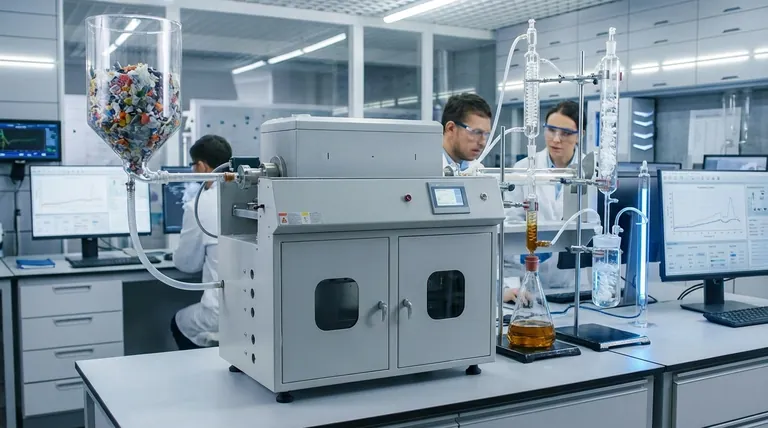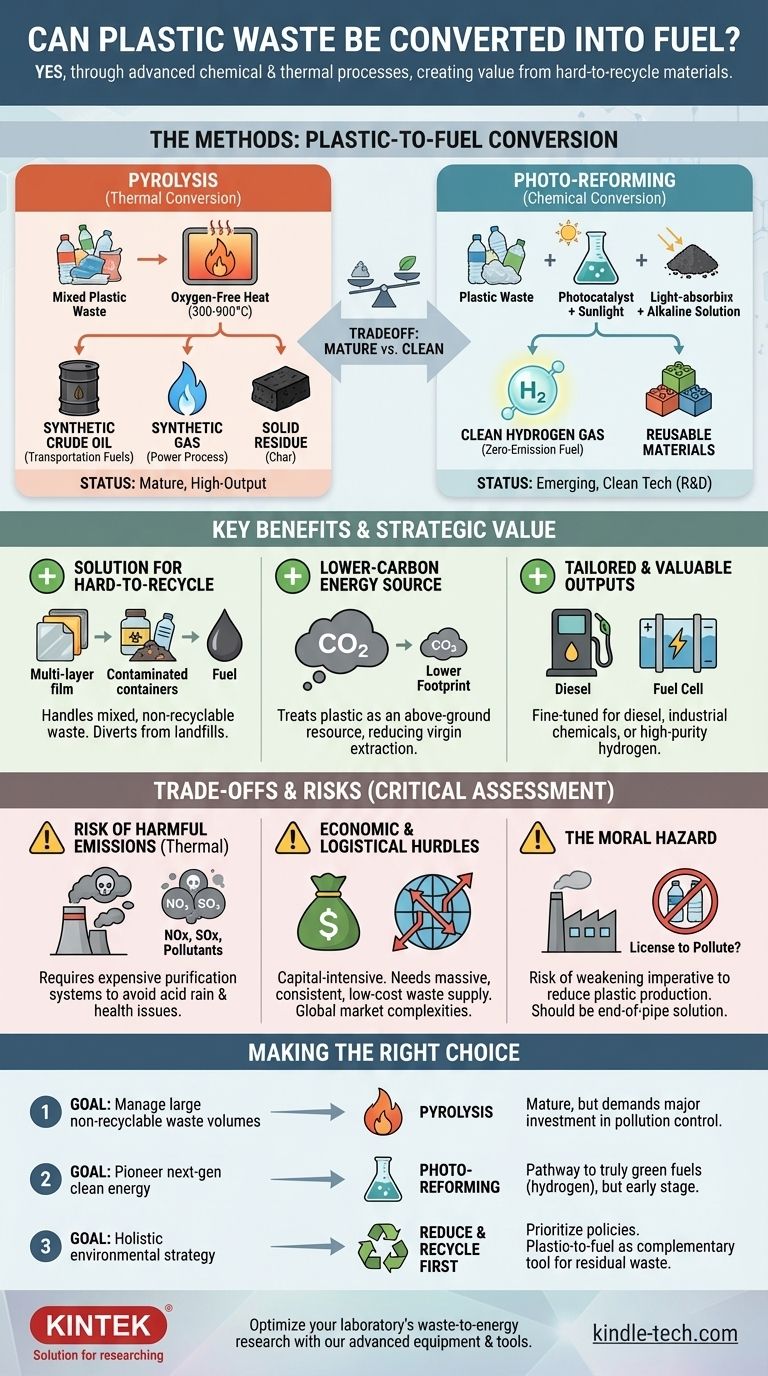Sim, os resíduos plásticos podem ser convertidos em combustível através de vários processos químicos e térmicos avançados. Tecnologias como a pirólise usam calor intenso para decompor plásticos em óleo cru sintético, enquanto métodos mais novos, como a fotorreforma, usam a luz solar para converter resíduos plásticos diretamente em gás hidrogênio limpo. Essas abordagens oferecem uma maneira de criar valor a partir de materiais de difícil reciclagem que, de outra forma, poluiriam nossos aterros sanitários e oceanos.
Embora a conversão de plástico em combustível seja tecnicamente viável e possa lidar com resíduos não recicláveis, sua viabilidade ambiental e econômica não é garantida. O método de conversão específico usado determina o resultado, com uma troca crítica entre processos maduros e de alta produção que acarretam riscos de poluição e tecnologias limpas emergentes que ainda não estão em escala.

Como o Plástico é Convertido em Combustível
O termo "plástico para combustível" abrange várias tecnologias distintas, cada uma com seu próprio processo e resultado. Os dois métodos mais proeminentes são a conversão térmica e química.
O Método Dominante: Pirólise
A pirólise é uma forma de conversão térmica. Envolve aquecer resíduos plásticos a temperaturas muito altas (300-900°C) em um ambiente sem oxigênio.
Esse calor intenso decompõe as longas cadeias poliméricas do plástico em moléculas menores e mais simples. Os principais produtos são um óleo cru sintético (óleo de pirólise), um gás sintético e um resíduo sólido chamado carvão (char).
O óleo resultante pode ser refinado posteriormente em combustíveis de transporte, enquanto o gás pode ser usado para alimentar o próprio processo de pirólise, criando um sistema parcialmente autossustentável.
O Método Emergente: Fotorreforma
Uma abordagem mais nova e promissora envolve a conversão química impulsionada pela luz. Pesquisadores desenvolveram um processo chamado fotorreforma.
Este método envolve a adição de um material absorvedor de luz (um fotocatalisador) ao plástico. Quando submerso em uma solução alcalina e exposto à luz solar, o catalisador usa a energia da luz para decompor o plástico.
Em vez de produzir um óleo semelhante a combustível fóssil, esse processo gera gás hidrogênio limpo e deixa para trás outros materiais reutilizáveis. Essencialmente, ele usa a luz solar para transformar resíduos plásticos em uma fonte de combustível de emissão zero.
Os Principais Benefícios da Tecnologia Plástico-para-Combustível
Quando implementada corretamente, a conversão de plástico em combustível apresenta uma solução atraente para dois dos desafios mais significativos do mundo: gestão de resíduos e produção de energia.
Uma Solução para Plásticos de Difícil Reciclagem
A reciclagem mecânica tem limites. Muitos plásticos, como filmes multicamadas, recipientes contaminados e certos tipos de polímeros, são difíceis ou impossíveis de reciclar tradicionalmente.
Os processos de plástico para combustível podem lidar com esses resíduos mistos, muitas vezes não recicláveis, desviando-os de aterros sanitários e impedindo que entrem no meio ambiente.
Uma Fonte de Energia de Baixo Carbono
Em comparação com a extração, refino e queima de novos combustíveis fósseis, o uso de resíduos plásticos existentes como matéria-prima pode resultar em uma pegada de carbono geral menor.
Trata o plástico como um recurso já existente, reduzindo a necessidade de extração de petróleo virgem e seu impacto ambiental associado.
Produtos Finais Adaptados e Valiosos
Os processos de conversão podem ser ajustados para criar produtos específicos. A pirólise pode ser otimizada para produzir óleo adequado para motores a diesel ou outros produtos químicos industriais.
Métodos emergentes como a fotorreforma criam hidrogênio de alta pureza, um combustível crítico para transporte limpo e processos industriais verdes.
Compreendendo as Trocas e Riscos
Apesar de sua promessa, a tecnologia plástico-para-combustível não é uma solução perfeita. Os desafios práticos e ambientais são significativos e devem ser ponderados em relação aos benefícios.
O Risco de Emissões Nocivas
Processos térmicos como a pirólise, se não forem equipados com sistemas de purificação de gás sofisticados e caros, podem liberar poluentes nocivos.
Estes incluem óxidos de nitrogênio (NOx) e dióxidos de enxofre (SOx), que contribuem para a chuva ácida e problemas respiratórios, bem como outros poluentes atmosféricos perigosos. A alegação de ser "ecologicamente correto" depende inteiramente da qualidade dos controles de emissão da instalação.
Obstáculos Econômicos e Logísticos
As usinas de plástico para combustível exigem um grande investimento de capital. Para serem economicamente viáveis, elas requerem um suprimento massivo, consistente e de baixo custo de resíduos plásticos.
Em algumas regiões, isso levou a uma dependência da importação de resíduos, criando um mercado global complexo para o lixo. Também pode haver o risco de minar economias mais sustentáveis construídas em torno da redução de resíduos e da reciclagem tradicional.
O Risco Moral: Uma Licença para Poluir?
A maior preocupação é que o foco no plástico para combustível possa enfraquecer o imperativo de reduzir a produção de plástico em primeiro lugar.
Esta tecnologia deve ser vista como uma solução de "fim de tubo" para resíduos existentes e inevitáveis, e não como uma desculpa para continuar produzindo plásticos de uso único sob a suposição de que eles podem simplesmente ser convertidos em energia.
Fazendo a Escolha Certa para o Seu Objetivo
A decisão de investir ou apoiar a tecnologia plástico-para-combustível depende inteiramente do objetivo específico que você pretende alcançar.
- Se o seu foco principal é gerenciar grandes volumes de resíduos municipais não recicláveis hoje: A pirólise é a tecnologia mais madura disponível, mas requer um grande investimento em sistemas de controle de poluição do ar para ser considerada uma escolha responsável.
- Se o seu foco principal é ser pioneiro em energia limpa de próxima geração: A fotorreforma e métodos de conversão química semelhantes oferecem um caminho para combustíveis verdadeiramente verdes, como o hidrogênio, embora estejam em um estágio inicial de prontidão tecnológica e comercial.
- Se o seu foco principal é uma estratégia ambiental holística: Priorize políticas que reduzam o consumo de plástico e melhorem a reciclagem mecânica primeiro. Veja o plástico para combustível como uma ferramenta complementar para os resíduos residuais que não podem ser eliminados ou reciclados.
Em última análise, aproveitar a energia do plástico é uma ferramenta poderosa na luta contra a poluição, mas sua implementação responsável exige uma avaliação clara tanto dos benefícios da tecnologia quanto de seus riscos inerentes.
Tabela de Resumo:
| Método | Processo | Saída Principal | Status |
|---|---|---|---|
| Pirólise | Decomposição térmica em ambiente sem oxigênio | Óleo cru sintético, gás, carvão (char) | Madura, comercialmente implantada |
| Fotorreforma | Decomposição química usando luz solar e um catalisador | Gás hidrogênio, materiais reutilizáveis | Emergente, em fase de P&D |
Otimize a pesquisa de conversão de resíduos em energia do seu laboratório com a KINTEK.
Como fornecedora líder de equipamentos e consumíveis de laboratório avançados, a KINTEK fornece as ferramentas necessárias para explorar e aumentar os processos de conversão de plástico em combustível — desde reatores de pirólise até instrumentos analíticos para monitorar os resultados. Quer você esteja desenvolvendo catalisadores de próxima geração ou validando controles de emissão, nossas soluções ajudam você a obter resultados precisos e confiáveis.
Entre em contato conosco hoje para discutir como podemos apoiar seus objetivos específicos de pesquisa e contribuir para um futuro mais sustentável.
Guia Visual

Produtos relacionados
- Forno de Tubo CVD Versátil Feito Sob Medida para Equipamentos de Sistema de Deposição Química em Fase de Vapor
- Forno de Mufla de 1700℃ para Laboratório
- Diamante CVD para Aplicações de Gerenciamento Térmico
- Liofilizador de Laboratório de Alto Desempenho
- Forno Tubular Dividido de 1200℃ com Tubo de Quartzo Forno Tubular Laboratorial
As pessoas também perguntam
- Quais são as desvantagens dos nanotubos? Os 4 principais obstáculos que limitam seu uso no mundo real
- Por que os nanotubos de carbono são importantes na indústria? Desbloqueando o Desempenho de Materiais de Próxima Geração
- Quais são os métodos de produção de CNTs? CVD escalável versus técnicas laboratoriais de alta pureza
- O que é o método do catalisador flutuante? Um guia para a produção de CNT de alto rendimento
- Todos os diamantes cultivados em laboratório são CVD? Compreendendo os Dois Métodos Principais



















